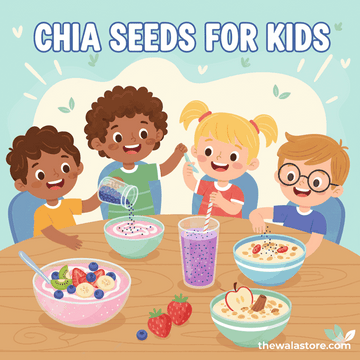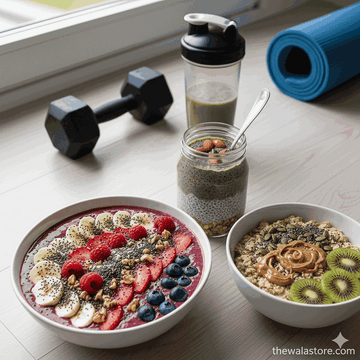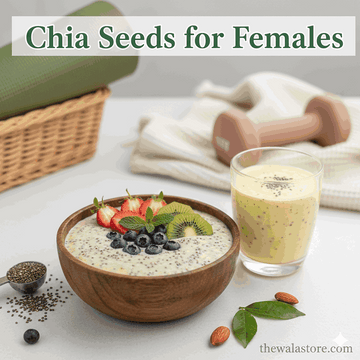Parents are always on the hunt for foods that actually help their kids grow strong and stay healthy, and chia seeds are one of those tiny things that pop up everywhere. At first glance, they look like nothing special, but once you soak them, they turn into a little nutrition bomb. They’ve got fiber for easy digestion, plant protein for growth, and omega-3s for brain power. Now, that doesn’t mean you can just scoop them in by the spoonful every day. Kids need the right amount, at the right age, and in the right form. That’s what we’ll break down here, simple and straight.
Are Chia Seeds Safe for Kids?
Most parents hear about chia seeds and think, “Okay, but can my kid actually eat this stuff safely?” The short answer: yes, but only when you give the right amount and in the right way.
Here’s a simple breakdown by age:
-
Toddlers (1–3 years): start with about half a teaspoon, always soaked.
-
Preschoolers (4–6 years): one teaspoon is plenty.
-
School-age kids (7–12 years): you can go up to 1–2 teaspoons daily.
-
Teens: one tablespoon max, no need to go beyond that.
And here’s the big rule never give them dry. Chia swells up a lot when it touches liquid, so if kids swallow them plain, it can be hard to digest or even cause choking. Soak them first in water, milk, or juice until they get that jelly-like texture.
Also, don’t rush it. Introduce small amounts at first and see how your child’s stomach reacts. Every kid is different some will handle it easily, others might need more time to adjust.
Health Benefits of Chia Seeds for Children
When it comes to superfoods for kids, chia seeds are often underrated. They’re tiny, sure, but they pack a serious punch when it comes to nutrition. If you use them the right way, they can help your child in more ways than one.
-
Growth & development: Chia brings in plant-based protein and amino acids that support muscle and overall growth. It’s a good option if your child doesn’t eat much meat or dairy.
-
Bone & teeth strength: With calcium and phosphorus, they help keep bones strong and teeth healthy. Many parents don’t realize these little seeds have more calcium than some dairy foods.
-
Brain focus: Omega 3 foods for children are important for memory and attention, and chia has plenty of it. Great for school-age kids who need that extra boost in class.
-
Stronger immunity: Antioxidants and minerals help protect against everyday colds and seasonal bugs.
-
Better digestion: Since they’re fiber-rich foods, chia seeds can prevent constipation, which is common in younger kids.
-
Steady energy: Their slow-releasing carbs keep kids full longer, perfect for busy school days or after-school activities.
Basically, you’re looking at one of the simplest ways to sneak extra nutrition into your child’s meals without making a fuss.
Possible Side Effects of Chia Seeds in Kids
Even though chia seeds are super healthy, they’re not totally risk-free. Like anything new in your kid’s diet, it’s good to know what could go wrong.
Common Issues
-
Choking hazard: If you just give them dry, they can swell in the throat scary for little kids. Always soak first.
-
Too much fiber: Overdoing it can make tummies bloated or upset, sometimes even diarrhea.
-
Allergies: Rare, but some kids might react. Keep an eye the first few times you serve them.
-
Calories: They’re small but pack energy. Too many can add up if your kid isn’t very active.
How Parents Can Avoid Side Effects
-
Soak chia seeds in water, milk, or juice let them puff up before giving to kids.
-
Start tiny. Even half a teaspoon can be enough for toddlers at first.
-
Mix into meals kids actually like pudding, smoothies, yogurt, or even porridge works great.
-
Watch for reactions. If anything seems off, pause and check with your pediatrician.
Honestly, if you just introduce them slowly and mix them into familiar foods, chia seeds usually don’t cause any problems. Most kids adjust really quickly, and it’s a painless way to sneak in some good nutrients.
Best Ways to Add Chia Seeds to Kids’ Diet
Okay, so now that we know chia seeds are safe and healthy when used right, let’s talk about actually getting them into your kid’s meals without a fight. Honestly, most kids won’t eat them plain, so you gotta be a little sneaky but in a tasty way.
-
Chia pudding with fruits: This one’s a classic. Just soak chia overnight in milk or a plant-based option and mix in banana, berries, or whatever fruit your kid likes. They barely notice, and it’s sweet enough to eat like dessert.
-
Smoothies & shakes: Toss a teaspoon into banana shakes, lassi, or even chocolate milk. It thickens things a little, but most kids love it.
-
Breakfast foods: Sprinkle them on porridge, oatmeal, custard, or cereal. Works especially well with yogurt bowls. Kids get extra fiber and protein without even realizing it.
-
Lunchbox ideas: You can mix chia into sandwiches, wraps, or even little snack balls. Tiny seeds don’t change the taste much, but they add nutrients.
-
Baking & snacks: Muffins, pancakes, roti, ladoos, energy bars chia can fit in almost any baked treat. It adds some bulk and fiber without making the food weird.
Basically, the trick is mix and match. Start small, hide them in things kids already like, and slowly they get used to the texture and taste. Pretty soon, adding chia seeds becomes just another normal part of their meals.
Best Time to Give Chia Seeds to Kids
Timing kinda matters when you give chia seeds to kids, not just the amount. Done right, they can really help with energy, digestion, and even keeping those cranky snack cravings away.
-
Morning: Giving chia in the morning like in oatmeal or a smoothie can give your kid steady energy for school. No sugar crash, just slow-releasing carbs keeping them going till lunch.
-
Afternoon snack: Toss some chia into yogurt, pudding, or even a little shake around 3–4 pm. It helps curb junk food cravings and keeps them full till dinner.
-
Night: A small warm chia milk before bed can be soothing and good for digestion. Some parents swear it even helps kids sleep better.
-
Avoid before sports/games: Chia swells a bit, so giving too close to running around or sports can feel heavy in the stomach. Better give it at least an hour or two before activity.
Honestly, it’s all about experimenting a little see what works for your child. Some kids love it first thing, others prefer it as a snack. Either way, chia seeds can fit nicely into their day without fuss.
FAQs on Chia Seeds for Kids
Q: Can kids eat chia seeds daily?
A: Yeah, kids eat chia seeds daily but in small amounts. Even a teaspoon or so a day is plenty for younger kids. Too much at once can upset tummies, so it’s better to start slow and see how your child reacts.
Q: How much chia seeds should a 2-year-old eat?
A: For toddlers around 2 years, just half a teaspoon soaked in water, milk, or yogurt is enough. You can slowly increase if they like it and handle it well.
Q: Is chia pudding good for children?
A: Totally! Chia pudding is one of the easiest ways to sneak nutrition in. Add some fruit or a little honey, and most kids will eat it without complaining. It’s soft, sweet, and full of fiber and protein.
Q: Can chia seeds help with constipation in kids?
A: Yep, the fiber in chia helps a lot. Just make sure the seeds are soaked first dry ones won’t help and might actually make digestion harder. Pair it with some water or milk for best results.
Q: Chia seeds vs flax seeds which is better for children?
A: Both are good, honestly. Chia has a bit more omega-3 and fiber, and it’s easier to use in puddings and smoothies. Flax is also great, but it’s usually ground to get the nutrients, while chia works right out of the bag after soaking.
Q: Can picky eaters get nutrition from chia seeds?
A: For sure. Mixing it into smoothies, yogurt, or even baked goods can sneak in nutrients without them noticing. Kids usually don’t mind the texture once it’s soaked and soft.
Q: Are chia seeds safe to pack in school lunch?
A: Yep, just make sure they’re soaked or mixed into something like pudding, muffins, or energy balls. Dry seeds could swell a bit, so soaked or blended is the way to go.
Final Thoughts Should You Add Chia Seeds to Your Child’s Diet?
Honestly, chia seeds are a tiny little superfood that can do a lot for your kid. They’re full of nutrients that help with growth, digestion, brain power, and even immunity. But don’t get carried away portion size really matters. Start small, soak them properly, and introduce them slowly so your child gets used to the texture and taste.
Even just a teaspoon or two in a smoothie, pudding, or breakfast bowl can make a noticeable difference over time. It’s one of the easiest ways to sneak in extra nutrition without turning mealtime into a battle. Adding chia seeds for kids in this simple way can really boost their diet naturally no fuss, no gimmicks, just a tiny boost of good stuff every day.






